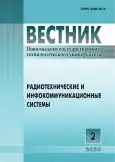Comparative Analysis of Noise Characteristics in High-Frequency Signal Generators Using Digital-to-Analog Converters
- 作者: Romashov V.V.1, Yakimenko K.A.1, Doctorov A.N.1, Groshkov I.D.2, Sochneva N.A.1
-
隶属关系:
- Murom Institute (branch) of Vladimir State University named after Alexander Grigorievich and Nikolai Grigorievich Stoletov
- JSC "Murom Radio Measuring Instruments Plant"
- 期: 编号 2 (2024)
- 页面: 6-16
- 栏目: Telecommunication and radio engineering
- URL: https://journal-vniispk.ru/2306-2819/article/view/270482
- DOI: https://doi.org/10.25686/2306-2819.2024.2.6
- EDN: https://elibrary.ru/TMKAYU
- ID: 270482
如何引用文章
全文:
详细
Introduction. The advancement of modern digital technology, the increase in productivity and operating clock frequency, and the development of specialized architectures for generating output signals have led to the creation of high-speed digital-to-analog converters (DACs). These converters are a crucial component of digital computing synthesizers, which are used to develop digital radio frequency signal generators. Goal. This paper aims at comparing methods for constructing digital signal generators based on high-speed DACs and analyze their noise characteristics. Methodology. The study presents various configurations for designing digital signal generators using high-speed DACs, including configurations with a mixer, a quadrature modulator, and special operating modes that enhance the efficiency of utilizing reference frequency images. Results. Analysis of simulation results indicates that the third configuration – a digital generator based on a high-speed DAC operating in special modes – exhibits the lowest level of phase noise. In RFZ3 mode, this configuration shows a phase noise level that is 10-14 dBn/Hz lower than that of the quadrature modulator-based generator and approximately 6-8 dBn/Hz lower than the mixer-based configuration. In RFZ4 mode, when utilizing the third positive image, a reduction of 15-22 dBn/Hz below the power spectral density (PSD) phase noise of the quadrature modulator-based generator and about 15-20 dBn/Hz below the mixer-based configuration is achieved. Additionally, the highest efficiency in utilizing images is obtained in higher Nyquist zones, where the increase in the output signal spectrum's envelope in special modes surpasses that in the DAC's primary NRZ mode. Conclusion. To effectively employ a digital signal generator based on high-speed DACs, frequency planning and the selection of optimal modes for analog signal restoration according to the image number used are necessary. Practical significance. The evaluation of the noise characteristics of the considered configurations, based on the proposed models, demonstrates that the use of the special operating modes of the DAC can significantly reduce the phase noise level of signal generators. Moreover, the use of high-speed DACs allows for the exclusion of analog elements from the signal generator structure, thereby significantly enhancing energy efficiency.
全文:
作者简介
Vladimir Romashov
Murom Institute (branch) of Vladimir State University named after Alexander Grigorievich and Nikolai Grigorievich Stoletov
编辑信件的主要联系方式.
Email: romashovmurom@mail.ru
ORCID iD: 0000-0002-7672-7164
SPIN 代码: 6930-2111
Doctor of Engineering Sciences, Professor, Head of the Department of Radio Engineering
俄罗斯联邦, 23, Orlovskaya st., Murom, 602264Kirill Yakimenko
Murom Institute (branch) of Vladimir State University named after Alexander Grigorievich and Nikolai Grigorievich Stoletov
Email: romashovmurom@mail.ru
ORCID iD: 0000-0001-7985-4479
SPIN 代码: 4740-1262
Candidate of Engineering Sciences, Associate Professor at the Department of Radio Engineering
俄罗斯联邦, 23, Orlovskaya st., Murom, 602264Andrey Doctorov
Murom Institute (branch) of Vladimir State University named after Alexander Grigorievich and Nikolai Grigorievich Stoletov
Email: romashovmurom@mail.ru
ORCID iD: 0000-0001-6074-6400
SPIN 代码: 6557-8166
Candidate of Engineering Sciences, Associate Professor at the Department of Radio Engineering
俄罗斯联邦, 23, Orlovskaya st., Murom, 602264Igor Groshkov
JSC "Murom Radio Measuring Instruments Plant"
Email: romashovmurom@mail.ru
SPIN 代码: 9264-7732
Design Engineer of the 1st category
俄罗斯联邦, 2, Karacharovskoe highway, Murom, 602267Natalya Sochneva
Murom Institute (branch) of Vladimir State University named after Alexander Grigorievich and Nikolai Grigorievich Stoletov
Email: romashovmurom@mail.ru
SPIN 代码: 4866-0215
PhD student at the Department of Radio Engineering
俄罗斯联邦, 23, Orlovskaya st., Murom, 602264参考
- Kroupa V. F. Direct Digital Frequency Synthesizers. USA, New-York: John Wiley & Sons; 1998. 396 p.
- Ivanov D.V., Ivanov V.A., Chernov A.A. Theoretical bases of the method of the direct digital synthesis of radio signals for digital communication systems. Vestnik of Volga State University of Technology. Series: Radio Engineering and Info-communication Systems. 2012;(1):3-34. (In Russ.).
- Ivanov D.V., Ivanov V.A., Mihadarova O.V. et al. Table, interpolation and iteration functional converters for the method of direct digital frequency synthesis. Vestnik of Volga State University of Technology. Series: Radio Engineering and Infocommunication Systems. 2017;(3):29-46. (In Russ.) doi: 10.15350/2306-2819.2017.3.29
- Ryabov I.V., Degtyarev N.V., Klyuzhev E.S., Strelnikov I.V. Formation of frequency-modulated signals using the direct digital synthesis method. Radioengineering. 2021;85(3):78−85. (In Russ.) DOI: https://doi.org/10.18127/j00338486-202103-08
- Ryabov I.V. Digital synthesis of precision signals: Monograph. Yoshkar-Ola, Mari State Technical University; 2005. 152 p. (In Russ.).
- Romashov V.V., Yakimenko K.A., Doktorov A.N., Groshkov I.D. Radar hybrid signal generators based on high-speed digital-to-analog converters. Russian open Armandovskie chtenija. Modern problems of remote sounding, radar, propagation and diffraction of waves. Proceedings of the Russian Open Scientific Conference. Murom: Murom Institute; 2021:390–394. (In Russ.).
- Kalcher M., Fulde M., Gruber D. Fully-digital transmitter architectures and circuits for the next generation of wireless communications. Elektro-technik&Informationstechnik. 2018;(135/1):89–98.
- Bicici C., Ozdur I., Cerezci O. Analysis of oscillator phase noise effect on high order QAM links. Analog Integrated Circuits and Signal Pro-cessing. 2020;105(1):1–6. doi: 10.1007/s10470-020-01701-1
- Romashov V.V., Yakimenko K.A., Doctorov A.N. et al. Hybrid frequency synthesizer based on high-speed digital-to-analog converter. Radio-tehnicheskie i Telekommunikacionnye Sistemy. 2022;4(48):51-59. (In Russ.) doi: 10.24412/2221-2574-2022-4-51-59.
- Kroupa V. F. Noise properties of PLL systems. IEEE Trans. 1982;30(10):2244–2252.
- Ryzhkov A.V., Popov V.N. Frequency synthesizers in radio communication technology. Мoscow, Radio i Svyaz; 1991. 256 p. (In Russ.).
- Rubiola E. Phase Noise and Frequency Stability in Oscillators. UK, Cambridge: Cambridge University Press; 2009. 203 p.
- Yakimenko K.A., Romashov V.V., Khramov et al. The research of phase noise of frequency synthesizers based on high-speed direct-to-analog converters. Radioengineering. 2023;87(11):180-191. (In Russ.) doi: 10.18127/j00338486-202311-23.
- Romashov V.V., Khramov K.K., Doktorov A.N. et al. Improving the efficiency of the use of higher nyquist zones in direct digital synthesis of high-frequency signals. Radioengineering. 2022;86(5):135-144. (In Russ.) doi: 10.18127/j00338486-202205-16
补充文件













